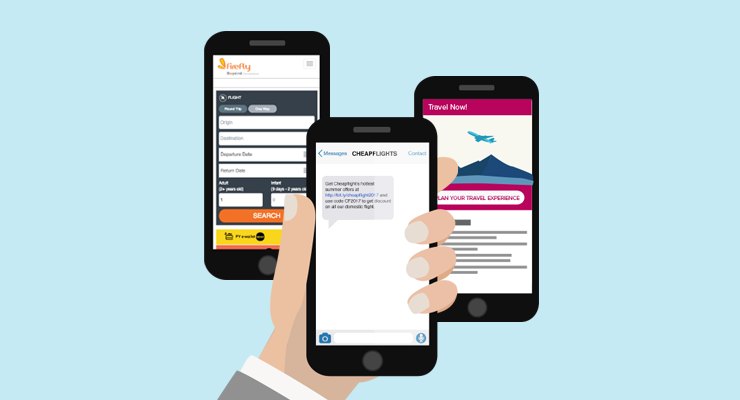Popularly known as “The Father of Spam”, it was in 1978 when Marketing Manager Gary Thuerk sent a mass email to customers advertising Digital Equipment Corporation’s machines. His campaign resulted in $13 million worth of sales for the company, as well as garnering a few complaints.
Despite some negative connotations that come with it, over the years email marketing has proved to be one of the quickest and most cost-effective marketing channels, beating out traditional methods such as snail mail and phone calls.
Forecasts predict that by the end of 2017, there will be 3.7 billion email users worldwide – that’s approximately half of the current world population sending and receiving 227 billion emails on a daily basis. Obviously there are a lot of opportunities to be made in email marketing, but how can you stand out and maximize it to your advantage
Behavioral email marketing
One of the biggest trends in digital is the ability to segment your audience and target them with customized messages based on their likes, interests, and activities. This is the process by which you send automated and targeted emails to contacts in your database, also known as behavioral email marketing (BEM).
It involves creating a strategy where a user’s interactions with your company are identified and analyzed across multiple channels (i.e. social media, email, company website). You then use these interactions or “triggers” to determine the type of content you will deliver to the user.
How Bloomingdale’s increased revenue by 50% through BEM
A 2017 study on Bloomingdale’s is the perfect example of how campaigns triggered by customer behavior aids in its performance.
Considering the size of the company and its variety of customers, US e-commerce website Bloomingdale’s needed a solution on how to personalize their email marketing campaigns to match their customers’ needs and behaviors.
Previously, the Marketing team would just send over batch-and-blast email campaigns which had the same content and messaging across all customers. In 2016, they applied BEM to their campaigns and focused on the following customer aspects as triggers:
- Shopping and browsing history
- Transaction-related emails like order and shipping confirmations
Tracking these behaviors allowed Bloomingdale’s to refine their campaigns and send customized messaging to their subscribers. For example, newsletter emails were triggered and contained products that a user has seen or engaged with but hasn’t yet purchased. The team also developed campaigns highlighting promotions, sales, and post-purchase follow-ups.
After a year, the company saw a 50% increase in revenue, mostly driven by triggered email campaigns. And with their new behavioral marketing strategy, they also received 5x more the number of email addresses collected.
Advantages of behavioral email marketing
Applying behavioral email marketing to your campaigns contributes to:
Increase in overall user engagement
According to a study by the Direct Marketing Association (DMA), Europe’s largest professional body representing the direct marketing industry, over 75% of revenue generated through e-mail marketing is generated through trigger campaigns. Users are more likely to engage with your brand if you show them curated and highly-targeted content, as compared to one-size-fits-all campaigns.
Higher conversion rates
Because you showed your customers targeted campaigns based on their activities and behavior, they’re more likely to be interested in the content that you deliver, which leads to higher probability of them purchasing your product.
Having multiple personas for one product
By showing your customers product options based on their specific behavior, you are improving their user experience and allowing them to relate to your brand on a personal level.
Viewing the customer as a multi-dimensional person
Marketers tend to have what you call “tunnel vision”, which is what happens when you promote a single product because a customer was interested in something from that niche. Through behavior-based marketing, you’re accepting that your customers are multi-faceted. It’s this acceptance that eventually leads them to having a better experience with your brand.
Behavioral email targeting is a method all marketers should apply to their campaigns. This strategy will allow you to understand your customers better and in a deeper manner, thus improving their overall interaction with your brand.
Ultimately, it’s about adopting a user-focused, customer-centric approach where the content received by customers is dictated by their actions and behavior, and not by the marketer.
Sources:
Boomtrain. (2017, May 8). 5 Amazing Advantages of Behavioural Targeted Emails. Retrieved from Boomtrain Inc.: https://boomtrain.com/5-advantages-using-behavioural-targeting-emails/
Eckerle, C. (2017, March 29). Email Marketing: How Bloomingdale’s saw a 50% increase in revenue driven by triggered campaigns. Retrieved from Marketing Sherpa: https://www.marketingsherpa.com/article/case-study/bloomingdales-email-marketing
Lee, G. (2013, May 24). The evolution of email marketing. Retrieved from Smart Insights: http://www.smartinsights.com/email-marketing/email-communications-strategy/email-marketing-evolution/
Moche, I. (2016, January 8). How to Create a Behavioral Email Marketing Strategy For Your Business. Retrieved from The Hubspot User Blog: https://blog.hubspot.com/customers/creating-a-behavioral-email-marketing-strategy
Radicati Team. (2017, February). Email Statistics Report, 2017-2021. Palo Alto, California : The Radicati Group, Inc.
Radicati Team. (2014, May). Email Statistics Report, 2014-2018. Palo Alto, California: The Radicati Group, Inc. .




